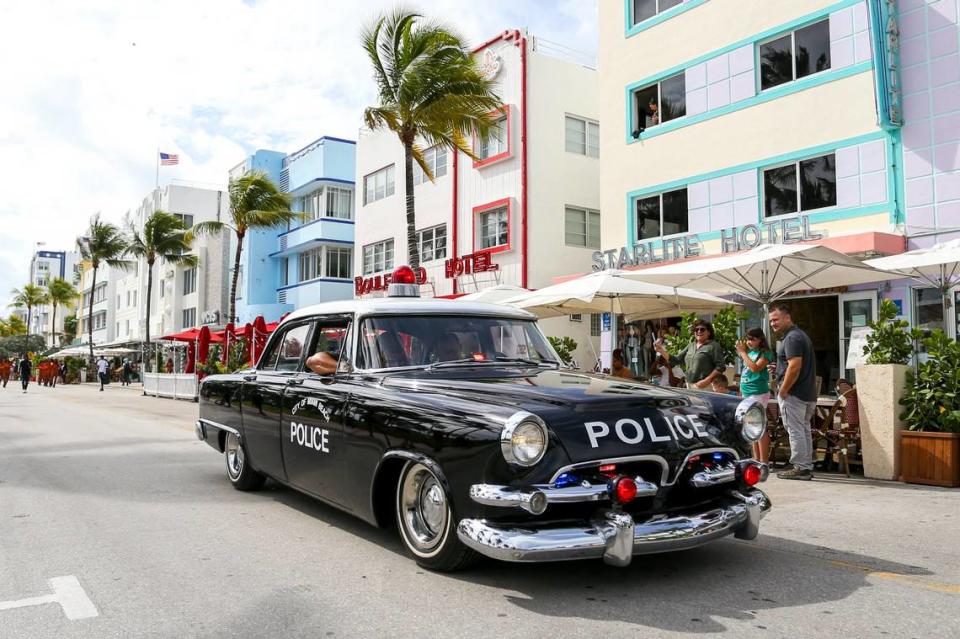Miami Beach considers ways to fight against the Clevelander’s affordable housing plan
Miami Beach officials are considering far-reaching measures to fight the effects of a new law designed to encourage affordable housing, including the possibility of suing the state of Florida and a proposal to reduce allowable building heights in much of South Beach.
The idea is to counteract a controversial new proposal by the owners of the Clevelander Hotel and Bar on Ocean Drive and any future projects built under Florida’s Live Local Act, which allows developers who set aside 40% of units for affordable or workforce housing to build as tall as local regulations allow within one mile of their projects.
In Miami Beach, that means the Clevelander owners could pursue a 30-story tower to replace the popular party spot and adjacent Essex House hotel. The proposal includes a ground-floor restaurant and residential building featuring a mix of market-rate condos and workforce rentals — a plan that local politicians and residents have quickly decried as destroying the Art Deco character of Ocean Drive, where building heights are limited to 50 feet.
On Wednesday, the City Commission referred an item to the city’s Planning Board asking staff to draft amendments to reduce building height regulations in South Beach neighborhoods within a mile of historic districts.
The item, sponsored by Mayor Dan Gelber and Commissioners Laura Dominguez, Alex Fernandez and Steven Meiner, would seek to limit the height of projects developers could propose under the Live Local Act. Most of South Beach is designated as historic, meaning the changes could affect broad swaths of the city.
“If it happened anywhere, it could happen everywhere,” Gelber said of the Clevelander proposal. “There’s no reason why any other parcel of land couldn’t do exactly the same thing.”
Changes would apply to new construction, rather than existing buildings. But they could render existing structures as nonconforming, meaning they would need to comply with the new regulations if they are torn down and rebuilt.
Many of Miami Beach’s tallest structures are located within historic districts, including famous Collins Avenue hotels like the 36-story, 484-foot Fontainebleau and the 38-story, 386-foot Setai.
The exact locations and details of potential height reductions were not immediately clear.

The Clevelander’s plan, which was announced in a press release last Thursday but has not been formally submitted to the city, is based on the maximum height allowed in the city’s Convention Center district, where hotels can be 30 stories and 300 feet tall.
“Most properties within historic districts in South Beach are well within a mile of districts that currently permit up to (and in some cases over) 200 feet of building height,” City Attorney Rafael Paz wrote in a memo to elected officials. “In order to mitigate the impacts of the Live Local Act on Miami Beach’s historic character, amendments to the city’s land development regulations are necessary, particularly to address maximum building heights within one mile of the city’s historic districts in South Beach.”
A representative for the Clevelander and its owner, Jesta Group, was not immediately available for comment.
Could city take legal action?
The Miami Beach City Commission on Wednesday also authorized the city attorney to explore legal action against the state to fight the Live Local Act, which has faced substantial backlash from other cities in South Florida.
“Let’s be proactive on this,” said Commissioner Kristen Rosen Gonzalez, noting that the city’s Art Deco district is listed on the National Register of Historic Places. “I think we should sue in federal court to protect our historic district,” she said.
City Attorney Rafael Paz said he would look into the possibility, but that his department has conferred with lawyers for other cities and that, so far, “no one has identified a legal deficiency in the Live Local Act as drafted.”

Gelber said the city should consider “whatever avenues are available,” warning that new towers built under the law could ultimately “make Sunny Isles look provincial” compared to Miami Beach. The city of Sunny Isles Beach has several tall towers on the oceanfront.
Fernandez added that Miami Beach could refuse to accept applications filed under the Live Local Act, as the cities of Doral and Weston have done — possibly in violation of state statute.
City may reject Clevelander plan
Officials said Wednesday that the city would likely reject the Clevelander proposal because it exceeds the allowable floor-area ratio (FAR) for Ocean Drive.
The Live Local Act says developments should still comply with local land development regulations, which would include FAR, a method of regulating building size.
“We would have no choice but to reject it if it doesn’t comply with the current FAR in the code,” said Paz, the city attorney, adding that it would be up to the City Commission to consider making an exception.
Alexander Tachmes, an attorney for the Clevelander, said last week that the proposal would exceed the floor-area ratio allowed on Ocean Drive, but said he believes it will still pass legal muster based on the intent of the state law.
“We vehemently disagree,” Paz said Wednesday.
Where would affordable housing be OK?
As housing costs skyrocketed during the pandemic, Miami Beach officials have said they want to provide more affordable options — something they have largely failed to do over the past decade.
But most have voiced opposition to the Clevelander’s housing plan, arguing Ocean Drive is the wrong place for a 30-story tower.
READ MORE: ‘It’s embarrassing’: Why does Miami Beach keep failing to meet affordable housing goals?
The plan by Jesta Group, which owns the Clevelander and Essex House, would likely designate around 55 of 137 residential units as affordable rentals under the Live Local Act, which defines affordable housing as units attainable for people making up to 120% of the area median income, or about $90,000 in Miami-Dade County.
That would mean studios could rent for more than $2,100 — still out of reach for many workers in South Florida’s hospitality industry but relatively affordable for a South Beach high-rise. The remaining, market-rate units would be condos, the ownership group said last week.
The Clevelander’s owners have said their proposal was a response to the city’s need for affordable housing and political pressure from city officials to roll back alcohol sale hours and tame the party atmosphere on Ocean Drive.
The Live Local Act, they say, gave them a viable financial path to build something new.
“There has been an effort over a number of years to try to change our business model on Ocean Drive,” Jesta Group senior managing director Anthony O’Brien said in a statement last week. The Live Local Act, O’Brien said, provided the “first opportunity we’ve seen as owners of this property that actually makes financial sense.”

